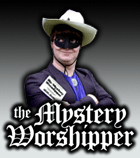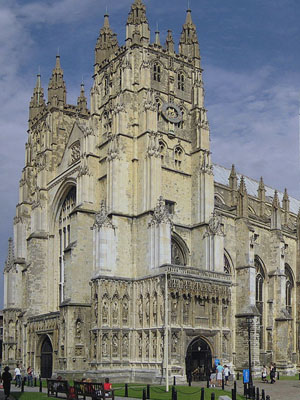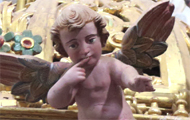| |
 |
 |
 |
| Comment on this report, or find other reports. |
 |
| Our Mystery Worshippers are volunteers who warm church pews for us around the world. If you'd like to become a Mystery Worshipper, start here. |
 |
| Find out how to reproduce this report in your church magazine or website. |
|
|
| 2508: Canterbury
Cathedral, England |
 |

Photo:
© Hans Musil and used under license
|
 |
Mystery
Worshipper: The Wife of Bath.
The church:
Cathedral
and Metropolitical Church of Christ at Canterbury, England.
Denomination:
Church
of England, Diocese
of Canterbury.
The building:
Canterbury Cathedral was founded by St Augustine, who came to
England as a missionary on the orders of Pope Gregory the Great
in AD597 and became the first Archbishop of Canterbury. Parts
of St Augustineís original building remain beneath the present
nave, and the site was already sacred in Roman times. Typically,
the building has been enlarged and altered over the centuries,
but parts of the early Norman construction remain in the north
transept, around the shrine to the martyrdom of St Thomas in
1170. Parts of the quire and some of the stained glass also
date from this time. There is a wealth of resources online detailing
the architecture and history of the building, but notable unique
features include the compass rose in the nave, marking the building
as the mother church of the worldwide Anglican communion, and
the shrine to the martyrdom of St Thomas Becket. The latter
marks the spot where Becket fell, and includes a small altar
called the Altar of the Swordís Point. The building is divided
internally by a massive screen at the crossing behind the nave
altar, so visibility between the nave and the quire and beyond
is negligible, making it a building of really two halves.
The church:
This service marked the inauguration of the 105th Archbishop
of Canterbury, a line stretching back to St Augustine 1,400
years ago, and this has been a place of daily worship for all
that time. It had been an abbey for 500 years until the dissolution
of the monasteries under Henry VIII in 1540, when it was closed
and plundered, and it suffered again during the civil war a
century later. The various activities of the cathedral employ
300 staff and 800 volunteers and include stained glass and stone
conservation work as well as a full calendar of worship, choir,
school and community events.
The neighbourhood:
The immediate neighbourhood was designated a UNESCO world heritage
site in 1988, marking the visual record of the introduction
of Christianity to Britain. The site includes the cathedral
precincts, St Augustineís abbey, and his original church, St
Martinís, the oldest church in England still in use today. The
medieval town is splendid although it suffered significant damage
in the Second World War. The Kingís School, within the cathedral
grounds, is arguably the oldest school in the world, having
possibly been founded by St Augustine himself. It took its current
name at the dissolution of the monasteries under King Henry
VIII. The city of Canterbury is only 17 miles from the port
of Dover, linking the British Isles to continental Europe, and
only 60 miles from London.
The cast:
In chronological order, rather than hierarchical: The Very Revd
Robert Willis, dean of Canterbury, gave the welcome and generally
presided. A teenage member of the congregation, Evangeline Kanagasooriam,
greeted the archbishop (a role historically filled by a male
church official) when he entered the cathedral by the west doors,
having knocked three times with his staff. Canon John Rees,
principal registrar of the Province of Canterbury, read the
mandate of installation. The Archbishop of York read the declaration
of assent (requiring the new archbishop to take the corporal
oath, which he did). The Rt Revd Jana Grinberga of the Lutheran
Church of Great Britain read the Old Testament lesson. The Roman
Catholic Archbishop of Westminster, the Most Revd Vincent Nichols,
read the New Testament lesson. The Archdeacon of Canterbury,
the Very Revd Sheila Watson, installed the new Archbishop of
Canterbury on his diocesan throne (the first woman ever to perform
this function), where the Bishop of London and Bishop of Dover
gave him blessings. The dean then sat him on the Chair of St
Augustine, where the Archbishop of Burundi pronounced a blessing
in French. The new archbishop gave the greeting of peace, read
the gospel, delivered the sermon and led the saying of the Nicene
Creed. Lay people from the diocese led the intercessions from
the compass rose in the nave, and the archbishop pronounced
the final blessing. Did I leave out anyone? Ah, mustn't forget
– the proceedings were held in the presence of His Royal
Highness The Prince of Wales, and Her Royal Highness The Duchess
of Cornwall.
The date & time:
Commemoration of Benedict, Abbot of Monte Cassino, and Thomas
Cranmer, Archbishop of Canterbury, Thursday, 21 March 2013,
3.00pm. The procession, consisting of everyone from the Sheriff
of Canterbury to the Archdeacon of Maidstone, began to enter
the west door almost an hour before the stated time. The archbishop
himself was flanked by no fewer than three chaplains: a woman
in front with the primatial cross, and two behind.
Comment:
We have received a comment on this report.
What was the name of the
service?
The Inauguration of the Ministry of the One Hundred And Fifth
Archbishop of Canterbury, Justin Portal Welby.
How full was the building?
It was as full as possible, with more than 2,000 people present. Seating was arranged facing the central aisle of the nave to accommodate the greatest possible number. Apparently the congregation had been greatly reduced for fire safety reasons compared to the services for previous archbishops, which must have made the guest list challenging for cathedral staff. The quire, transepts and seating around the high altar appeared to be reserved for honoured guests and many of the hundreds of people taking part in various processions.
Did anyone welcome you personally?
There were many marshals on duty checking tickets at the door
and directing us to our designated seats, on which the order
of service had been placed.
Was your pew comfortable?
Where we were, the chairs were modern linked wooden ones –
comfortable enough, especially as there was a fair amount of
movement, standing for processions, hymns and so on. Elsewhere,
in the quire and so forth, Iím sure there would have been stalls
and other kinds of seating.
How would you describe
the pre-service atmosphere?
The doors opened an hour before we had been instructed to be
in our seats, so the nave was already fairly full long before
the official start time of three oíclock. However, the processions
began 50 minutes before the first official words were spoken,
so there was plenty of activity. We had already sung two hymns
and witnessed two lengthy processions and the entrance of Their
Royal Highnesses before the service formally started.
What were the exact opening words of the
service?
"Welcome to this ancient cathedral church of Christ in Canterbury."
The dean went on to extend the welcome to those who were joining
us in their homes from all over the world, as the service was
broadcast live on radio and television.
What books did the congregation use during the
service?
There was a 44-page order of service, available for download
here.
What musical instruments were played?
The organ was played by Matthew Martin. The bells were rung before and after the service by the Cathedral Company of Change Ringers. There was an amazing interlude of African drumming and dancing just before the reading of the gospel Ė I say amazing, not because it is an unusual feature of such services (itís not) but because it was really loud, which made it quite literally resounding. We couldnít see the dancers but we could certainly hear the performance. The cathedral acoustics were tremendous. Our line of sight was not great, but we heard every word and every note.
Did anything distract you?
There were plenty of distractions, from playing the identification
game on the faces in the crowd and occasionally making a discreet
sign of recognition to acquaintances, to watching the cameras
move and swivel on their silent booms, to observing the security
guards lurking at the back and the movements of the marshals,
the comings and goings through a side door that introduced a
wintry breeze every time it opened. There was one man, evidently
a doctor, who was summoned away from his seat, black bag in
hand, a couple of times. I was also amused to notice that one
of the sign-language interpreters diligently translated even
the Te Deum Laudamus as it was sung by the choir, although
the words were printed out in full in the order of service.
Was the worship stiff-upper-lip, happy clappy, or
what?
It was extremely formal, completely scripted, and parts of it were archaic and were only redeemed from tedium by the fact that they were so momentous and unusual. However, it still managed to be genuinely joyful and there was such a lot of enthusiastic music and singing that it was never dull.
Exactly how long was the sermon?
9 minutes.
On a scale of 1-10, how good was the preacher?
9 – Obviously Archbishop Justin had prepared the sermon,
but he also improvised. The printed version available on his
website does not include his opening quip, which was about
the "good reverberation" in the cathedral. He spoke well and
clearly and his message was clear.
In a nutshell, what was
the sermon about?
The gospel reading was Matthew 14: 22-33 – where Jesus
walks on water and commands Peter to get out of the boat. The
sermon, in a nutshell, was about faith transcending fear. Archbishop
Justin said that on this occasion he could certainly relate
to Peter's fear and trembling, but that when it's Jesus who
is calling, the utterly absurd becomes completely reasonable.
He also talked about the new Pope Francis calling us in humility
and simplicity to become the fully human community of which
we all dream.
Which part of the service
was like being in heaven?
Well, it was just a privilege to be there. The singing was great
fun. There were nine congregational hymns, including one written
by the dean of Canterbury. And the organ music and choir pieces
were beautiful, while the African drumming was breathtaking.
And which part was like being in... er... the other place?
Visibility from where we sat, a few rows back in the middle
of the nave, was pretty dire. There were a few TV screens, but
they were quite small and placed quite high at the bottom of
the windows, so their efficacy was minimal. Furthermore, the
bright lights for the cameras made seeing anything on them even
more difficult. So we couldnít actually see much of what went
on, other than the processions as they passed. There was a whole
interlude when various members of the Anglican Communion placed
symbolic objects on the altar, and we could barely make out
what was happening. Fortunately the order of service kept us
informed. Also, it was extremely cold, but we can't blame the
planners for the weather.
What happened when you hung around after the service looking lost?
We were lucky enough to be invited to a tea, so it wasn't a
question of hanging around looking lost. We had no idea where
to go, but helpful stewards and, eventually, signage pointed
the way until there was an obvious crowd to follow.
How would you describe the after-service
coffee?
There were a variety of teas in different venues, to which different
categories of guests had evidently been invited with colour-coded
tickets. There was also a huge exodus from the cathedral gates,
indicating that not everyone had such an invitation. Our ticket
entitled us to enjoy real tea and lovely cakes in a building
located on the other side of the compound. It was very welcome
indeed, as we were chilled to the bone after the service and
the brisk walk to get there.
How would you feel about making this church your regular (where 10 = ecstatic, 0 = terminal)?
10 – Sadly, we donít live in Canterbury. However, I would give that a 10 out of 10 too, so yes, I would love to live and worship in this lovely corner of England if I could afford to!
Did the service make you feel glad to be a
Christian?
Yes. It was a real privilege to be there, and what a week to
be a Christian, with Pope Francisís similar ceremony just two
days earlier. This service was visibly ecumenical, and that
felt good.
What one thing will you remember about all this in seven days' time?
The endless processions. |
|
|
 |
 |
 |
| We rely on voluntary donations to stay online. If you're a regular visitor to Ship of Fools, please consider supporting us. |
 |
 |
 |
| The Mystery Pilgrim |
 |
| One of our most seasoned reporters makes the Camino pilgrimage to Santiago de Compostela in Spain. Read here. |
 |
 |
 |
| London churches |
 |
| Read reports from 70 London churches, visited by a small army of Mystery Worshippers on one single Sunday. Read here. |
| |
|
|
|
|


